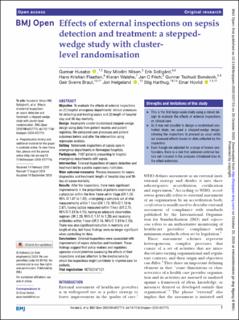| dc.contributor.author | Husabø, Gunnar | |
| dc.contributor.author | Nilsen, Roy Miodini | |
| dc.contributor.author | Solligård, Erik | |
| dc.contributor.author | Flaatten, Hans | |
| dc.contributor.author | Walshe, Kieran | |
| dc.contributor.author | Frich, Jan C | |
| dc.contributor.author | Bondevik, Gunnar Tschudi | |
| dc.contributor.author | Braut, Geir Sverre | |
| dc.contributor.author | Helgeland, Jon | |
| dc.contributor.author | Harthug, Stig | |
| dc.contributor.author | Hovlid, Einar | |
| dc.date.accessioned | 2021-04-27T07:20:53Z | |
| dc.date.available | 2021-04-27T07:20:53Z | |
| dc.date.created | 2020-10-20T19:20:39Z | |
| dc.date.issued | 2020 | |
| dc.identifier.issn | 2044-6055 | |
| dc.identifier.uri | https://hdl.handle.net/11250/2739758 | |
| dc.description.abstract | Objective To evaluate the effects of external inspections on (1) hospital emergency departments’ clinical processes for detecting and treating sepsis and (2) length of hospital stay and 30-day mortality.
Design Incomplete cluster-randomised stepped-wedge design using data from patient records and patient registries. We compared care processes and patient outcomes before and after the intervention using regression analysis.
Setting Nationwide inspections of sepsis care in emergency departments in Norwegian hospitals.
Participants 7407 patients presenting to hospital emergency departments with sepsis.
Intervention External inspections of sepsis detection and treatment led by a public supervisory institution.
Main outcome measures Process measures for sepsis diagnostics and treatment, length of hospital stay and 30-day all-cause mortality.
Results After the inspections, there were significant improvements in the proportions of patients examined by a physician within the time frame set in triage (OR 1.28, 95% CI 1.07 to 1.53), undergoing a complete set of vital measurements within 1 hour (OR 1.78, 95% CI 1.10 to 2.87), having lactate measured within 1 hour (OR 2.75, 95% CI 1.83 to 4.15), having an adequate observation regimen (OR 2.20, 95% CI 1.51 to 3.20) and receiving antibiotics within 1 hour (OR 2.16, 95% CI 1.83 to 2.55). There was also significant reduction in mortality and length of stay, but these findings were no longer significant when controlling for time.
Conclusions External inspections were associated with improvement of sepsis detection and treatment. These findings suggest that policy-makers and regulatory agencies should prioritise assessing the effects of their inspections and pay attention to the mechanisms by which the inspections might contribute to improve care for patients. | en_US |
| dc.language.iso | nob | en_US |
| dc.publisher | BMJ | en_US |
| dc.relation.uri | https://bmjopen.bmj.com/content/10/10/e037715 | |
| dc.rights | Navngivelse-Ikkekommersiell 4.0 Internasjonal | * |
| dc.rights.uri | http://creativecommons.org/licenses/by-nc/4.0/deed.no | * |
| dc.title | Effects of external inspections on sepsis detection and treatment: a stepped-wedge study With cluster-level randomisation | en_US |
| dc.type | Journal article | en_US |
| dc.type | Peer reviewed | en_US |
| dc.description.version | publishedVersion | en_US |
| dc.rights.holder | Copyright 2020 The Authors | en_US |
| dc.source.articlenumber | e037715 | en_US |
| cristin.ispublished | true | |
| cristin.fulltext | original | |
| cristin.qualitycode | 1 | |
| dc.identifier.doi | 10.1136/bmjopen-2020-037715 | |
| dc.identifier.cristin | 1841006 | |
| dc.source.journal | BMJ Open | en_US |
| dc.source.40 | 10 | |
| dc.identifier.citation | BMJ Open. 2020;10:e037715 | en_US |
| dc.source.volume | 10 | en_US |

